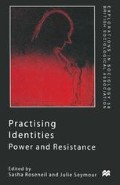Abstract
National identity plays an important role in identifying who we are as individuals. However, we are not born with a sense of national identity, it has to be inculcated. What it means to belong to a particular nation, to have a sense of that identity, is constructed by a diverse range of forces, including governments, the media and the community lived in. This chapter sets out to explore how the federal government of Australia sought to construct national identity around a particular idea of citizenship in an attempt to construct an identity that recognized and was inclusive of the ethnic and cultural diversity that existed within Australian society.
Access this chapter
Tax calculation will be finalised at checkout
Purchases are for personal use only
Preview
Unable to display preview. Download preview PDF.
References
Barnett, D. (1986) ‘How the Bloated Ethnic Industry is Dividing Australia’, The Bulletin,18 February, pp. 58–62.
Billig, M. (1995) Banal Nationalism (London: Sage).
Birrell, R. (1988) ‘The FitzGerald Report on Immigration Policy: Origins and Implication’, Australian Quarterly,60(3), pp. 261–74.
Blainey, G. (1984) All for Australia (Melbourne: Methuen Haynes).
Bolkus, N. (1995) Press release B111/95 (http://www.immi.gov.au).
Bolkus, N. (1996) Text of speech to the Culture and Citizenship Conference, Brisbane, 2 October.
Bottomore, T. (1992) Commentary, in Marshall and Bottomore (1992).
Castles, S. (1992a) ‘The Australian Model of Immigration and Multiculturalism: Is it Applicable to Europe’, International Migration Review,XXVI(2), pp. 549–67.
Castles, S. (1992b) ‘Australian Multiculturalism: Social Policy and Identity in a Changing Society’, in G. Freeman and J. Jupp (eds), Nations of Immigrants: Australia, the United States and International Migration (Sydney: Oxford University Press).
Clark, C. M. H. (Manning) (1993) History of Australia (Sydney: Pimlico).
Collins, J. (1988) Migrant Hands in a Distant Land: Australia’s Post-War Immigration (Sydney: Pluto Press).
Connor, W. (1978) ‘A Nation is a Nation, is a State, is an Ethnic Group, is a …’, Ethnic and Racial Studies,1(4), pp. 377–400.
Department of Immigration and Multicultural Affairs (1997) Parliamentary Statement on Racial Tolerance (http://www.immi.gov.au/package/poster.htm).
FitzGerald Report (1988) see Report of the Committee to Advise on Australia’s Immigration Policies.
Four Corners (1997) ‘The New Believers’ (weekly current affairs digest), Australian Broadcasting Commission,16 June 1997.
Fraser, M. (1997) ‘Why Racial Hatred Hurts Us All’. Lecture given on 21 October and produced in full in The Age (http://www.theage.com.au/daily/971022/news/news27.html).
Freeman, G. and Betts, K. (1992) ‘The Politics of Interests and Immigration and Policymaking in Australia and the United States’, in G. Freeman and J. Jupp (eds), Nations of Immigrants: Australia, the United States and International Migration (Sydney: Oxford University Press).
Freeman, G. and Jupp, J. (1992) ‘Comparing Immigration Policy in Australia and the United States’, in G. Freeman and J. Jupp (eds), Nations of Immigrants: Australia, the United States and International Migration (Sydney: Oxford University Press).
Garnaut, R. (1989) Australia and the Northeast Asian Ascendancy (Canberra: Australian Government Publishing Service).
Hobsbawm, E. (1990) Nations and Nationalism since 1780 (Cambridge: Cambridge University Press).
Jakubowicz, A. (1981) ‘State and Ethnicity: Multiculturalism as Ideology’, Australian and New Zealand Journal of Sociology,17(3), pp. 4–13.
Jayasuriya, L. (1990) ‘Rethinking Australian Multiculturalism as Ideology’, Australian Quarterly,Autumn, pp. 50–63.
Jupp, J. (1995) ‘From “White Australia” to “Part of Asia”: Recent Shifts in Australian Immigration Policy Towards the Region’, International Migration Review,XXIX (1), pp. 207–28.
Jupp, J. (1991) ‘Multicultural Public Policy’, in C. Price (ed.), Australian National Identity (Canberra: Academy of the Social Sciences in Australia).
Mann, M. (1996) ‘Ruling Class Strategies and Citizenship’, in M. Bulmer and A. Rees (eds), Citizenship Today: The Contemporary Relevance of T. H. Marshall (London: UCL Press).
Marshall, T. H. and Bottomore, T. (1992) Citizenship and Social Class (London: Pluto). [Marshall’s essay, ‘Citizenship and Social Class’, is followed by Bottomore’s commentary.]
McKenna, M. (1996) The Captive Republic: A History of Republicanism in Australia, 1788–1996 (Cambridge: Cambridge University Press).
Menzies, R. (1967) Afternoon Light: Some Memories of Men and Events (London: Cassell & Co).
Office of Multicultural Affairs (1989) The National Agenda for a Multicultural Australia (Canberra: Australian Government Publishing Service).
Price, C. (1987) ‘Australia: Multicultural and Non-Racist’, New Community,14 (1/2), pp. 241–4.
Report of the Committee to Advise on Australia’s Immigration Policies, (1988) Immigration: A Commitment to Australia (Canberra: Australian Government Publishing Service).
Rees, A. (1996) ‘T. H. Marshall and the Progress of Citizenship’, in M. Bulmer and A. Rees (eds), Citizenship Today: The Contemporary Relevance of T. H. Marshall (London: UCL Press).
Smith, A. (1986) The Ethnic Origin of Nations (Oxford: Blackwell).
Smith, A. (1991) National Identity (London: Penguin).
Smolicz, J. (1991) ‘Who is an Australian? Identity, Core Values and the Resilience of Culture’, in C. Price (ed.), Australian National Identity (Canberra: The Academy of the Social Sciences in Australia), pp. 41–66.
Whitlam, E. G. et al. (1997) ‘The Hanson Statement’, produced in full in The Age (http://www.theage.com.au/daily/971107/news/news25.html).
Editor information
Editors and Affiliations
Copyright information
© 1999 British Sociological Association
About this chapter
Cite this chapter
Clarence, E. (1999). Citizenship and Identity: the Case of Australia. In: Roseneil, S., Seymour, J. (eds) Practising Identities. Explorations in Sociology. British Sociological Association Conference Volume Series. Palgrave Macmillan, London. https://doi.org/10.1007/978-1-349-27653-0_10
Download citation
DOI: https://doi.org/10.1007/978-1-349-27653-0_10
Publisher Name: Palgrave Macmillan, London
Print ISBN: 978-0-333-74759-9
Online ISBN: 978-1-349-27653-0
eBook Packages: Palgrave Social & Cultural Studies CollectionSocial Sciences (R0)

